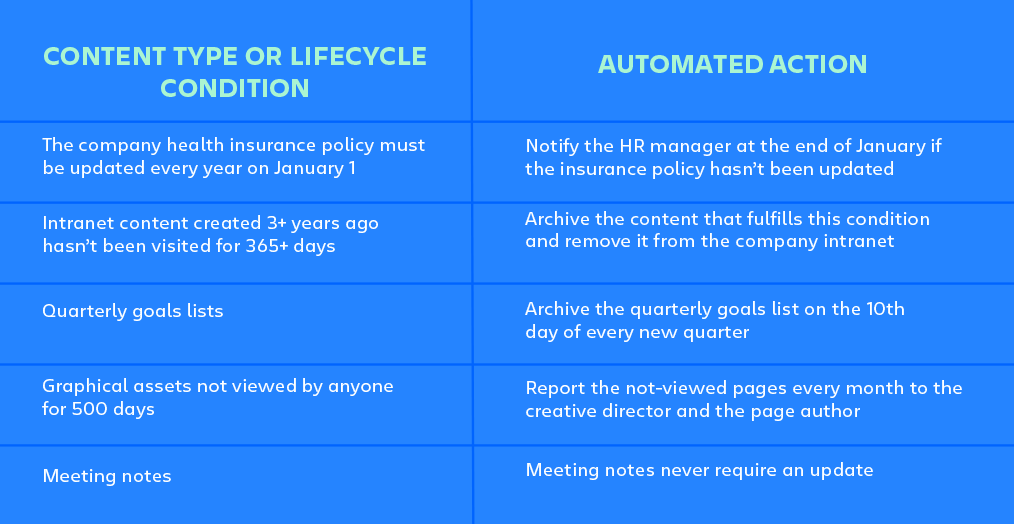An end to data dumping grounds
Keep your content at bay with ECM lifecycles and automation advice from an expert.
Imagine this: the Enterprise Content Management (ECM) system at your company uses a clear structure and hierarchy to organize information on a particular subject. The value in having a clear structure of content is obvious to everyone; institutional knowledge is more accessible and users can find needed information quickly, making the content management process frictionless. In theory, this results in less stress and improved effectiveness for everyone relying on this central source of work-related knowledge.
As a manager of the ECM, your job is to guard this structure, which reflects your team’s preferred method of organizing content. You keep an eye out so as your team grows, new joiners don’t rock the boat by, say, adding new hierarchy layers and content categories without checking for duplicates and redundancy.
It probably seems like you have it all figured out.
Then, your HR manager catches you in the elevator with her own story: employees keep submitting health insurance claims using an outdated form. She realized that the page that contains the health insurance policy from two years ago is still getting comments and likes, and still being circulated throughout the company.
When you ask passionately, “Why didn’t you remove it? Archive it? Update it?!” her reply is sobering: the HR department alone owns hundreds of pages. With so much information to organize, it’s hard to keep every page updated and relevant.
It’s an eye-opening realization: you spent so much time creating rules for the physical organization of content, you forgot about the aspect of time: how long should a piece of content be considered up-to-date?
The experience of the HR manager sheds light on two important things:
- It’s not enough to simply organize content in a physical structure; you also need to define each document’s “best-before date” and regulate your content accordingly.
- Individual contributors can’t be expected to maintain every piece of content. It’s ripe for automation.
Defining the “best-before date” for your ECM content
Setting a “best-before date” for ECM content starts by defining its type. To do this, you need to identify each kind of content your teams have in the ECM. Different types of content will have different “best-before” dates or conditions, and you should take that into account when determining what will happen with them when they meet that condition.
If your ECM allows for it, create content categories, so it’s easier to overview them. For example, in Confluence, you can organize your Spaces (the highest level of content organization) into categories, which might reflect departments or areas of expertise. Using an app like Better Content Archiving, you can visualize them all at once.
After creating your Space categories, think about the “best-before” date for each — a number of days after which you want an automatic action performed, like archiving or removing content, or have a responsible colleague notified. For example, sales reports should be automatically archived after 180 days; employee benefits documentation should be reviewed by HR every 365 days; marketing should be notified of intranet content that hasn’t been read for 60 days, and so on.
Once you’ve defined your content types and the “best-before” date and its ensuing action, you have established your ECM’s lifecycle rules. The next step is to automate the execution of these rules and set the content lifecycle in motion.
Automating your ECM content cleanup
As you learned from your HR manager in our hypothetical scenario, it’s not realistic to expect each and every team member to follow, revisit, and maintain every piece of content they create in Confluence. You could have the most thoughtful lifecycle rules in place, but without Content Lifecycle Management (CLM), an automated system that executes them, your rules are powerless.
A CLM app like Better Content Archiving can run your lifecycle rules for each of your Spaces, automating the actions those rules dictate, freeing ECM content managers from having to chase down users to update their pages or remove obsolete content manually. Automation also increases the efficiency and productivity of end users, as they never need to sift through outdated versions of documents again.
Let’s explore some specific lifecycle rules examples and their associated actions:

Better Content Archiving for Confluence also provides content health metrics and usage data, which helps you understand the performance of the content on the company intranet.
Creating these CLM rules is fairly easy (dare I say fun!) when you’re rolling out your ECM system or in the early years of using it. But keep in mind that if you wait too long, deciding which outdated page should stay and which should go, and who is responsible, will be more like firefighting, and user frustration will be sky-high. Introducing CLM early preserves the value of your investment in your ECM by boosting user adoption and keeping it from filling up with old content.
If you use Confluence as your ECM system, make sure you check out Better Content Archiving for Confluence, the go-to CLM app for Confluence Server and Data Center.


